Historical Crimea War medal pair 4 bars E Arnold India New Zealand North America
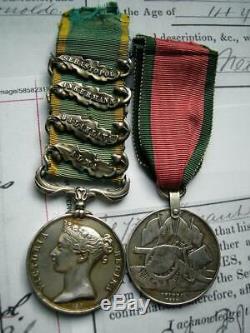
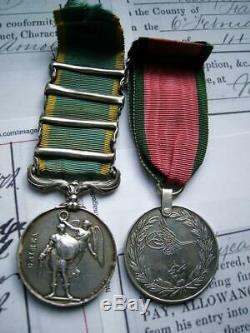
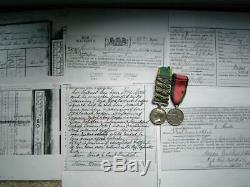
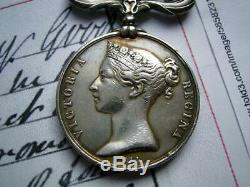
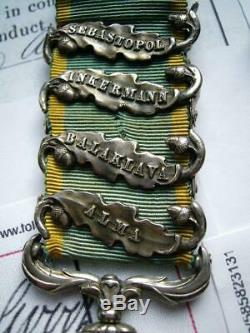
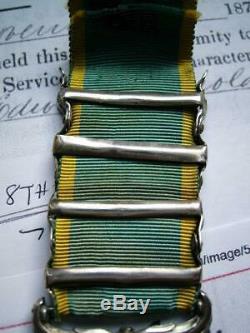
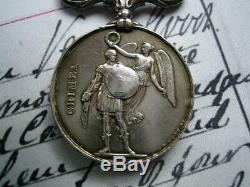
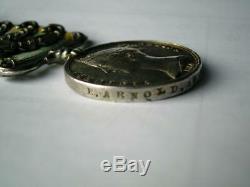
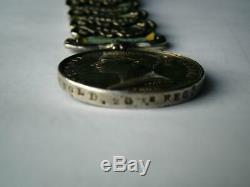
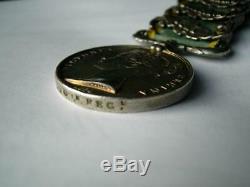
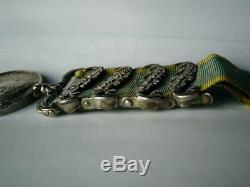

Interesting varied History, Crimea 1854-56 medal pair. Served in Crimean war 1854-56 with 20th Rgt earning medal pair, also entitled Indian Mutiny Medal & Lucknow clasp, also New Zealand Medal (Maori wars 1860s) stationed North America and earned Long Service Good Conduct medal, finally retired after 25 years aged 39 Sergeant 68th Rgt.
Historical Crimea War medal pair 4 bars E Arnold India New Zealand North America. HISTORICAL CRIMEA WAR MEDAL 1854-56, Private Edward Arnold 20th Regiment, (East Devon Rgt) Interesting varied History, Crimea 1854-56 medal pair, British medal has battle bars for Alma, Balaclava, Inkermann and Sebastopol, named "E Arnold 20th Regt" Official impressed name, 3285 Private Edward Arnold 20th Regiment (East Devonshire), some signs of reasonable light use and wear, good detail, IMO about Very Fine, light contact marks, few light scratches, minor light edge marks, comes with copy medal roll and about Very fine Ottoman Turkish medal (Scarce British issue "CRIMEA 1854") unnamed as issued, some marks and light wear. Supplied with some fascinating varied service history, please see pictures for condition Attested 67th Regiment (South Hampshire) in 1849 Newport, Isle of Wight, Hampshire, aged only 14 years, occupation shoemaker, claimed born London, but lived in Isle of Wight and his residence when retired after 25 years long service. Transferred in 1850 aged 15 years to 20th Regiment (East Devonshire), stationed with regiment in North America for 3 1/2 years (an under aged Private). Aged 18, fought in Crimean war 1854-56 with 20th Rgt, earning Crimea Medal with four battle bars and Ottoman Crimea medal (more scarce British issue).
Stationed East Indies (India) for 6 1/2 years, also entitled Indian Mutiny Medal & Lucknow clasp. Transferred to the 68th Regiment 1863 (Durham Light Infantry), fought in Maori wars 1864-66 promoted to Corporal 1865 then Sergeant 1866 (stayed 2 1/2 years in New Zealand) and earned New Zealand Campaign medal. Battle of the Alma September 1854. The Battle of the Alma was a battle in the Crimean War between an allied expeditionary force made up of French, British and Turkish forces and the Russian forces defending the Crimea on 20. The allies had made a surprise landing in Crimea on 14.
The allied commanders, Marechal Jacques Arnaud and Lord Raglan, then marched towards the strategically important port-city of Sevastopol, 45 kilometres (28 mi) away. The Russian commander, rushed his available forces to the last natural defensive position before the city, the Alma Heights, south of the Alma River. The allies made a series of disjointed attacks. The French turned the Russian left flank with an attack up cliffs which the Russians had considered unscalable.
The British initially waited to see the outcome of the French attack, then twice unsuccessfully assaulted the Russian's main position on their right. Eventually superior British rifle fire forced the Russians to retreat. With both flanks turned the Russian position collapsed and they fled.
The lack of cavalry meant that there was little pursuit. The battle cost the French 1,600 casualties, the British 2,000 and the Russians some 5,000.
Battle of Balaclava October 1854. Fought on 25 October 1854 during the Crimea war. Was part of Siege of Sevastopol. To capture the port and fortress of Sevastopol.S principal naval base on the Black Sea. To the Russians it is known as the battle of Kadikoi.
The engagement followed the earlier Allied victory in September at the Battle of Alma. Where the Russian General Menshikov. Had positioned his army in an attempt to stop the Allies progressing south towards their strategic goal. Alma was the first major encounter fought in the Crimea. Since the Allied landings at Kalamita Bay on 14 September, and was a clear battlefield success; but a tardy pursuit by the Allies failed to gain a decisive victory, allowing the Russians. To regroup, recover and prepare their defence. Battle of Inkerman November 1854. Was fought during the Crimea War. On 5 November 1854 between the allied armies of Britain, France. The battle broke the will of the Russian Army to defeat the allies in the field, and was followed by the Siege of Sevastopol. The role of troops fighting mostly on their own initiative due to the foggy conditions during the battle has earned the engagement the name "The Soldier's Battle". Despite being severely outnumbered, the allied troops held their ground, becoming a marvel of each regiment's tradition and tenacity. The amount of fog during the battle led to many of the troops on both sides being cut off, in battalion-sized groups or less. Thus, the battle became known as "The Soldier's Battle". The Russian attack, although unsuccessful, had denied the allies any attempt at gaining a quick victory in the Siege of Sevastopol and condemned the allied armies to two terrible winters on the heights. Following this battle, the Russians made no further large-scale attempts to defeat the allies in the field. By his account allied casualties were: 2,573 British, of whom 635 were killed, and 1,800 French, of whom 175 were killed.Russia lost 3,286 killed within a total (including men taken prisoner) of 11,959 casualties. CRIMEA WAR ANGLO FRENCH FLEET ENGAGING THE RUSSIANS SEBASTOPOL 1854-56. The Allies had had time to consider the problem, the French being brought around to agree that the key to the defence was the Malakoff.
Several weeks of fighting saw little change in the front line, and the Mamelon remained in Russian hands. General Brown and his staff. In April 1855, the allies staged a second all-out bombardment, leading to an artillery duel with the Russian guns, but no ground assault followed. On 24 May 1855, sixty ships containing 7,000 French, 5,000 Turkish and 3,000 British troops set off for a raid on the city of Kerch east of Sevastopol in an attempt to open another front on the Crimean peninsula and to cut off Russian supplies.When the allies landed the force at Kerch, the plan was to outflank the Russian army. The landings were successful, but the force made little progress thereafter. Many more artillery pieces had arrived and had been dug into batteries.
In June, a third bombardment was followed after two days by a successful attack on the Mamelon, but a follow-up assault on the Malakoff failed with heavy losses. The resulting Battle of Tchernaya was a defeat for the Russians, who suffered heavy casualties.
For months each side had been building forward rifle pits and defensive positions, which resulted in many skirmishes. Artillery fire aimed to gain superiority over the enemy guns. September saw the final assault on 5 September, another French bombardment (the sixth) was followed by an assault by the French Army on 8 September resulting in the capture of Malakoff by the French, and following the failure of the Russians to retake it, the collapse of the Russian defences. Meanwhile, the British captured the Great Redan, just south of the city of Sevastopol. The Russians retreated to the north, blowing up their magazines, and the city fell on 9 September 1855 after a 337-day-long siege. At this point, both sides were exhausted, and no further military operations were launched in the Crimea before the onset of winter.The main objective of the siege, the destruction of the Russian fleet and docks, took place over winter. On 28 February 1856, multiple mines blew up the five docks, the canal, and three locks. Create your brand with Auctiva's. Attention Sellers - Get Templates Image Hosting, Scheduling at Auctiva. The item "Historical Crimea War medal pair 4 bars E Arnold India New Zealand North America" is in sale since Wednesday, May 15, 2019.
This item is in the category "Collectables\Militaria\19th Century (1800-1899)\Medals/ Ribbons". The seller is "theonlineauctionsale" and is located in Offchurch. This item can be shipped worldwide.
- Country/Region of Manufacture: United Kingdom
- Country/ Organization: Great Britain
- Issued/ Not-Issued: Issued
- Type: Medals & Ribbons
- Conflict: Crimean war 1854-56
- Service: Army
- Era: 1816-1913

